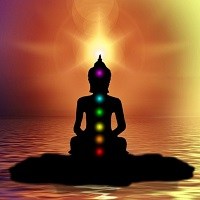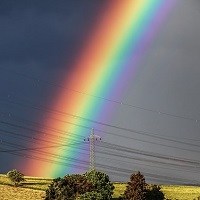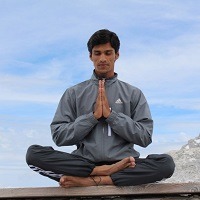 There’s a lot of talk about energy and vibrations right now, and it doesn’t look like that’s going to change any time soon. But what does it mean and how does this energy affect us? Can we use these vibrations to improve our health and have a happier life? Before we can begin to answer these questions, first we need to understand the chakras and their meanings.
There’s a lot of talk about energy and vibrations right now, and it doesn’t look like that’s going to change any time soon. But what does it mean and how does this energy affect us? Can we use these vibrations to improve our health and have a happier life? Before we can begin to answer these questions, first we need to understand the chakras and their meanings.
Chakra Origins
The word “chakra” comes from the Sanskrit language and translates as “wheel.” This ancient Indian language is one of the oldest in the world and the earliest known Hindu writings were in Sanskrit, in the form of Vedas. These Vedas – written between 1500 and 700 B.C. – contained hymns, philosophy and information on sacred ceremonies and rituals.
The first mention of the chakra system (i.e. the system linking the body’s energy centres) was in the Vedas. Some of the most important Buddhist and Jainist texts were also written in Sanskrit, and these religions share the belief in the importance of the chakras and their influence on our health and wellbeing.
What’s a Chakra?
So, the chakras are energy centres – but what exactly do they do? To answer this, imagine spinning funnels of energy – life force energy in fact. You may know this energy as chi, ki or prana. If you’re not familiar with any of these terms, put quite simply, it’s the energy that makes us what and who we are – our life force or soul if you like.
There are many of these funnels at different places on and around our body, but there are 7 main ones. These major chakras are located from the base of the spine, in a vertical line up to the top of the head. They each have their own characteristics, vibrational frequency and are related to specific aspects of our lives and health.
 When the chakras are healthy and working as they should, the life force energy flows freely, nourishing our body, calming our mind and emotions and nurturing our spirit. All of the energy centres are interconnected and when they are healthy, they work in sync to keep us happy and in good shape.
When the chakras are healthy and working as they should, the life force energy flows freely, nourishing our body, calming our mind and emotions and nurturing our spirit. All of the energy centres are interconnected and when they are healthy, they work in sync to keep us happy and in good shape.
However, if one of the energy centres is out of sync, it’s going to affect the others, and therefore our general health if left untreated. If a chakra becomes sluggish, less of the vital life force will flow through or around it. Others may also slow down, or quite often they will work extra hard and become over-active in an effort to compensate for the energy blockage elsewhere.
Any number of things can cause a chakra to become imbalanced – from a relationship break-up to stress at work. As we’re living amidst a stress epidemic, it’s more important now than ever to gain a better understanding of our energy centres, and discover ways to heal ourselves and recover from the inevitable knocks and traumas that we experience constantly in our modern world.
The 7 Major Chakras
The chakra system is composed of 7 major, 21 minor and 86 lesser chakras. They are each interconnected and are as important as each other for our overall health and wellbeing, but for the purposes of this article, we will be focusing on the 7 major chakras.
- The first is the base or root chakra. This is located at the base of the spine and is primarily associated with our sense of security, basic needs and being grounded. The associated colour is red and the energy here is the densest. (Chakra energy becomes less dense and energetic vibrations get higher as you progress upwards towards the crown.)
- Next is the sacral chakra which is located in the lower abdomen, below the navel, and is primarily associated with our sexuality, sensuality and creativity. It’s represented by the colour orange.
- The third is the solar plexus or navel chakra. It’s located mid-torso and relates predominantly to our personal power. Here the colour is yellow.
- The heart chakra is next. This can be seen as the bridge between the lower and upper chakras, linking our physical and spiritual selves. It relates to love and relationships and is found in the centre of the chest area. The colour associated is mainly green (although it’s often represented by pink as well.)
- Next is the throat chakra which is located – as you would expect – in the throat area. It represents self-expression and the colour here is blue.
- The sixth is the third eye or brow chakra and here the energy is becoming lighter still. The colour is indigo, and as this is the penultimate major chakra, we move closer to the spiritual realm. It’s located between the eyebrows and is mainly associated with our intuition and life purpose.
- Finally, the crown chakra which relates to our higher consciousness and connection to all that is. It’s located at the top of the head and from here our energy flows out towards the universe. The colour mainly associated is violet, but it’s also represented by purple, gold or white.
 Our energy centres each have their own vibrational frequencies which match their associated spectral colours. In addition, musical notes, mantra sounds, feelings and much more each relate to a particular frequency. (In fact everything in the universe has a vibrational frequency as everything is energy.) When these frequencies are in harmony, things work better – they are in sync.
Our energy centres each have their own vibrational frequencies which match their associated spectral colours. In addition, musical notes, mantra sounds, feelings and much more each relate to a particular frequency. (In fact everything in the universe has a vibrational frequency as everything is energy.) When these frequencies are in harmony, things work better – they are in sync.
This information can be used to great advantage for chakra healing – by harmonising frequencies to improve health and wellbeing. For example, listening to or chanting a mantra which resonates with the throat chakra can help us to improve our communication skills. (Overall balance and energy flow is important, but in order for us to achieve optimum health, we will usually need to focus on one or more areas first before this is possible.)
Chakras and Complementary Therapy
Most complementary therapies either go hand in hand with chakra healing, or link very closely to it. Some examples as follows :
Reiki
Chakras are of great importance in reiki healing. Although there are different types of reiki, Usui is the best known and most popular in Western Society. A traditional Usui Reiki treatment will follow a sequence of hand movements where the life force energy is channelled through the healer to the recipient’s individual chakras. Usually a few minutes is spent at each energy centre, but if the practitioner senses an irregularity or energy blockage, they will spend more time where they feel it is needed.
Crystal Healing
There are many different methods of healing with crystals. You can wear them (e.g. as jewellery), or carry them with you throughout the day (e.g. holding them or having them in your pocket). You could also have them under your pillow as you sleep or place them around your home or work place. Different crystals have different frequencies and a great way to use crystals for healing is to place an associated crystal at each chakra point as you receive a reiki treatment – thus boosting the healing energy as it flows through.
Aromatherapy
Why not go for the triple whammy? For each chakra there are essential oils that work particularly well. To give healing an extra boost, you could diffuse your choice of oils whilst receiving a reiki treatment with a crystal at each chakra! Essential oils are one of mother nature’s most fabulous gifts, but please use them wisely and be aware of safety precautions and risks before using.
Yoga
 There are so many different elements to yoga and so many different styles. To some, yoga may mean physical poses or asanas. To others it may mean meditation. To others breathing exercises or chanting mantras…plus more. All aspects of yoga can benefit the chakras. On the physical side, there are particular asanas that work best for each one. For example, the “Garland Pose” is good for the root or base – it’s a squatting position with some variations involving a gradual stretch reaching closer and closer to the ground. This answers our need to be grounded at the first of the major chakras.
There are so many different elements to yoga and so many different styles. To some, yoga may mean physical poses or asanas. To others it may mean meditation. To others breathing exercises or chanting mantras…plus more. All aspects of yoga can benefit the chakras. On the physical side, there are particular asanas that work best for each one. For example, the “Garland Pose” is good for the root or base – it’s a squatting position with some variations involving a gradual stretch reaching closer and closer to the ground. This answers our need to be grounded at the first of the major chakras.
In addition to complementary therapies (the list of which goes on and on), there are a number of other activities that can help the chakras. See the individual articles (links above) to find out about healing with food, herbs, colour, and affirmations.
I’ll also be covering meditation / contemplation and sound healing in a separate article, so watch this space for further details.
Conclusion
The importance of the chakras was first acknowledged many years ago. In our Western world there’s an upwards trend and growing interest in the importance of the chakras and how they relate to our health and wellbeing. There are many ways to heal the chakras with complementary therapies, and many people incorporate these healing methods into their daily life in order to maintain balance and give the body’s own healing system a regular boost.
Of course overall chakra health is important, but if you are in need of a little T.L.C. for a particular energy centre, follow the links above to find out more about the individual chakras, signs of a healthy / unhealthy chakra and healing methods specific to each.
As always, if you have health concerns or known medical issues, please contact your G.P. or other relevant health professional.
Finally…thoughts and feedback on the above? Please leave your comments in the box below or email me on jane@therapyjet.net. Thanks.





❤❤❤ Loving all this information ❤❤❤ x
Hello lovely, thank you for your kind words – I’m so pleased you like! I’m kind of mind blown at the moment – whilst working on the chakra series I’ve come across so many types of healing therapy I wasn’t really aware of before. It’s like I’m in a sweet shop but just checked out the store room out back which is wall to wall with all these new tasty treats I’ve never seen before! Wow, the creative juices are flowing…I’ve been listening to binaural beats to get my gamma brainwaves working! All will be revealed in my next article on Binaural Beats Therapy. Will post the link when it’s finished! xxx